高中英语过去分词用法详解ppt课件
合集下载
高中英语语法过去分词的用法(30张)ppt课件

to be produced B. produced C. being produced D. having produced
;
区别
①过去分词做定语:表被动,表完成。 ②如今分词作定语:表自动,表进展。 ③不定式作定语:表示将要发生的动作。
;
2. 过去分词作表语
位于系动词后,不表示“被动〞或“完成〞, 而表示主语的形状或心情,相当于描画词。
(encourage).
• We were __e_n__c_o_u_r_a_g_e_d__ (encourage )at
what he said.
• The football game is very _b_o_r_i_n_g__(bore). • We were _b_o_r_e_d__(bore) at the football
“觉得类〞: feel, sound, smell, taste “变成类〞:become, go, get, grow, fall, turn “依然类〞:remain, stay, keep
;
V-ing 与V-ed 作表语的区别
• What he said was e_n__c_o_u_r_a_g_i_ng
south foot of the mountain is a sea of
trees.
〔陕西2021〕
A. Seen
B. Seeing
C. Having seen
D. To see
;
2. ______ twice, the postman refused to
deliver our letters unless we chained
the time. 4. 2.带有“致使〞含义的动词: have, make 5. 〔1〕留意〞have sth done〞的两种用法: 6. ①表示让某人做某事,如: 7. I have had my bike repaired . 8. The villagers had man;y trees planted just then.
;
区别
①过去分词做定语:表被动,表完成。 ②如今分词作定语:表自动,表进展。 ③不定式作定语:表示将要发生的动作。
;
2. 过去分词作表语
位于系动词后,不表示“被动〞或“完成〞, 而表示主语的形状或心情,相当于描画词。
(encourage).
• We were __e_n__c_o_u_r_a_g_e_d__ (encourage )at
what he said.
• The football game is very _b_o_r_i_n_g__(bore). • We were _b_o_r_e_d__(bore) at the football
“觉得类〞: feel, sound, smell, taste “变成类〞:become, go, get, grow, fall, turn “依然类〞:remain, stay, keep
;
V-ing 与V-ed 作表语的区别
• What he said was e_n__c_o_u_r_a_g_i_ng
south foot of the mountain is a sea of
trees.
〔陕西2021〕
A. Seen
B. Seeing
C. Having seen
D. To see
;
2. ______ twice, the postman refused to
deliver our letters unless we chained
the time. 4. 2.带有“致使〞含义的动词: have, make 5. 〔1〕留意〞have sth done〞的两种用法: 6. ①表示让某人做某事,如: 7. I have had my bike repaired . 8. The villagers had man;y trees planted just then.
高三英语语法复习课件:过去分词

5. She was glad to see her child well_____ care of. A. take B. to be taken C. taken D. taking 6.The result of the entrance exams was not made _____to the public until last Thursday. A.knowing B. known C.to know D.to be known 7. I can make you _____what I say,but you can’t make yourself____in English. A.understand; understand B.understand; understood C.to understand; understand D.understand; to be understood
3.With a lot of difficult problems_____, the newly-elected president is having a hard time. A.settled B.settling C.to settle D.being settled 4.With trees,flowers and grass_____ everywhere, my native town had taken anew look. A.planting B.planted C.to plant D.to be planted
8.He found them____at a table_____ A.sat; to play chess B.sitting; to play chess C.seated; playing chess D.seat; play the chess 9. John rushed out in a hurry,___ the door_____. A.leaving; unlocked B.leaving; unlocking C.left, unlocked D.to leave;unlocking
过去分词的各种用法课件精编版

【注意】过去分词所表示的动作一定和宾 语有逻辑上的动宾关系。
“with +宾语+过去分词”结构
“with +宾语+过去分词”结构中,过去分词用作介词 with的 宾语补足语。这一结构通常在句中作时间、方式、条件、原因 等状语。例如:
(1) The murderer was brought in, with his hands tied behind his back. 凶手被带进来了,他的双手被绑在背后。(表方式) (2) With water heated, we can see the steam. 水一被加热,我们 就会看到水蒸气。(表条件) (3) With the matter settled, we all went home. 事情得到解决, 我们都回家了。(表原因) (4) She stood in front of him, with her eyes fixed on his face. 她 站在他面前,眼睛注视着他。 (5) He stood for an instant with his hand still raised. 他仍然举着 手站了一会儿。
(1) Given another hour, I can also work out this problem.
再给我一个小时,我也能解这道题。( given 为过去分词作状语,它的逻辑主语为 主句主语 I ,即 I 被再给一个小时。)
(2) Seen from the top of the hill, the city looks more beautiful to us.
当我们听到英勇事迹后很受感动。
过去分词作定语
1.
We must adapt ourselves to the changed conditions.
“with +宾语+过去分词”结构
“with +宾语+过去分词”结构中,过去分词用作介词 with的 宾语补足语。这一结构通常在句中作时间、方式、条件、原因 等状语。例如:
(1) The murderer was brought in, with his hands tied behind his back. 凶手被带进来了,他的双手被绑在背后。(表方式) (2) With water heated, we can see the steam. 水一被加热,我们 就会看到水蒸气。(表条件) (3) With the matter settled, we all went home. 事情得到解决, 我们都回家了。(表原因) (4) She stood in front of him, with her eyes fixed on his face. 她 站在他面前,眼睛注视着他。 (5) He stood for an instant with his hand still raised. 他仍然举着 手站了一会儿。
(1) Given another hour, I can also work out this problem.
再给我一个小时,我也能解这道题。( given 为过去分词作状语,它的逻辑主语为 主句主语 I ,即 I 被再给一个小时。)
(2) Seen from the top of the hill, the city looks more beautiful to us.
当我们听到英勇事迹后很受感动。
过去分词作定语
1.
We must adapt ourselves to the changed conditions.
高中英语 过去分词的用法全面(共46张ppt)
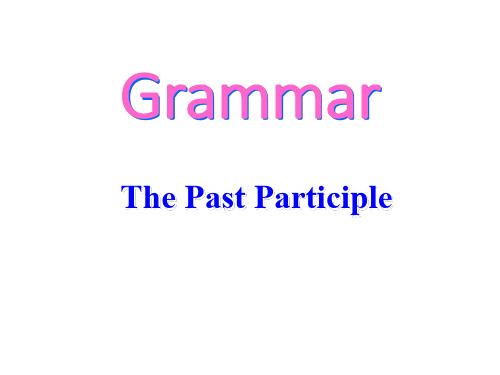
quite importanBiblioteka e. being discussed
to be discussed
注:ing分词作定语有时意义不同:
flying fish 飞鱼 a running dog 走狗 a falling tide 落潮 a crying boy 哭着的孩子
a running machine a swimming pool a waiting room a walking stick a fishing pole a reading room
eg: surprised/ surprising; encouraged/ encouraging; moved/ moving...
二、作定语 (attribute)
1. 前置定语:单个的v-ed作定语,一般放在 被修饰的n.之前; 后置定语:v-ed短语作定语时,常被放在被 修饰的n.之后,相当于一个定语从句。 eg: an invited guest 一位受到邀请的客人
eg: The cup is broken. 系表结构表状态
The cup was broken by Tom. 被动语态表动作
注意比较:
3. 过去分词v-ed和v-ing作表语的区别:
过去分词v-ed: 表主语(人)所处的心理状态, 个人的感受. “(人)感到...”
现在分词v-ing: 表主语(物或人)所具有的特征. “(物或人)令人...”
eg: The letter posted today will reach you in a week. =
The letter which was posted today will...
(2) 若是vi.的过去分词作定语只表示动作的完 成,不表被动,可改成v.用完成时态的定语 从句。
to be discussed
注:ing分词作定语有时意义不同:
flying fish 飞鱼 a running dog 走狗 a falling tide 落潮 a crying boy 哭着的孩子
a running machine a swimming pool a waiting room a walking stick a fishing pole a reading room
eg: surprised/ surprising; encouraged/ encouraging; moved/ moving...
二、作定语 (attribute)
1. 前置定语:单个的v-ed作定语,一般放在 被修饰的n.之前; 后置定语:v-ed短语作定语时,常被放在被 修饰的n.之后,相当于一个定语从句。 eg: an invited guest 一位受到邀请的客人
eg: The cup is broken. 系表结构表状态
The cup was broken by Tom. 被动语态表动作
注意比较:
3. 过去分词v-ed和v-ing作表语的区别:
过去分词v-ed: 表主语(人)所处的心理状态, 个人的感受. “(人)感到...”
现在分词v-ing: 表主语(物或人)所具有的特征. “(物或人)令人...”
eg: The letter posted today will reach you in a week. =
The letter which was posted today will...
(2) 若是vi.的过去分词作定语只表示动作的完 成,不表被动,可改成v.用完成时态的定语 从句。
高中英语-动词过去分词用法(共41张PPT)

Complete the table with phrases that have the same meaning.
terrified people people terrified of (cholera)
reserved seats
seats reserved for …
polluted water
_w_h_i_c_h_w__e_r_e_w_a_s_t_e_d_i_n_w__o_o_d_s_! • 我喜欢穿这种布料做的衣服。 • I like wearing clothes
_m__a_d_e_o_f_t_h_i_s_k_i_n_d_o_f__cl_o_t_h_. • I like wearing clothes
• The building being built is our library.
v-ed作宾补
• 作宾语补足语的过去分词一般来自及物动词, 表示被动和完成的意义。过去分词作宾补时, 和它前面的宾语构成“宾语+过去分词”的 复合结构,在这种结构中,宾语与过去分词 之间的逻辑上的动宾关系。
某些及物动词 (如make)
• We found the trees planted. • We found many people planting trees there. • I saw him go into the dining room.
• I saw her come into the classroom. • I saw her coming into the classroom. • I saw her taken out of the classroom.
Usage of The Past Participle
高中英语过去分词的用法课件(共53张PPT)

– Can those ____ at the
back of the classroom
hear me?
A. seat
B. sit
C. seated D. sat
35、___ in the queue for half an hour, the man suddenly realized he had left the money in the car. A. Waiting B. To wait C. Having Waited D. To have waited
非谓语动词的用法讲解:
过去分词的用法
过去分词作定语
作定语用的过去分词相当于形容词,表被动或表完成
1. 过去分词用作定语,如果是单个词语,常置于其所修 饰的名词之前。
The injured workers are now being taken care of in the hospital.
2.过去分词用作定语,如果是短语,一般置于其所修饰的 名词之后,其意义相当于一个定语从句。
The two theories were interesting. The news were disappointing. The result of the exam is delighting. What he does is satisfying.
• They were __s_u_rp__ri_s_e_d__ at the news.(惊奇于)
因为写得匆忙,这篇文章不是很好。
值得注意的是,有些过去分词作状语时不表 被动而表主动。这样的过去分词及短语常见 的有:
lost ( 迷 路 ) ; seated ( 坐 ) ; hidden ( 躲 ) ; stationed ( 驻 扎 ) ; lost / absorbed in ( 沉 溺 于 ) ; born (出身于); dressed in (穿着); tired of (厌烦)。
高中英语过去分词用法详解解析
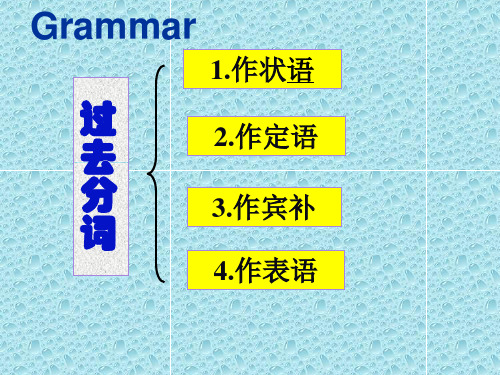
存在着逻辑上的被动关系, 且表示该动
作已经完成。单个的过去分词作定语,
通常置于被修饰的词的前面, 而分词短
语作定语, 则须置于被修饰词的后面。
用过去分词作状语来改写句子。
1. As I was worried about the journey, I was unsettled for the first few days. → Worried _______________________ about the journey , I was unsettled for the first few days.
the fire
Find out the sentences with same meaning.
1. As I was worried about the journey, I was unsettled for the first few days. Worried about the journey, I was unsettled for the first few days.
Difference between the Present Participle and the Past Participle _____for a long time, the book looks old. Used 由于用了很长时间,这本书看上去很旧. ______ Using the book, I find it useful. 在使用的过程中,我发现这本书很有用. Looking at her, he jumped with joy. ________ _______at Looked by her, he jumped with joy.
的动作发生在谓语动词之前, 则可使用现在
高考英语一轮复习——过去分词课件(共39张PPT)
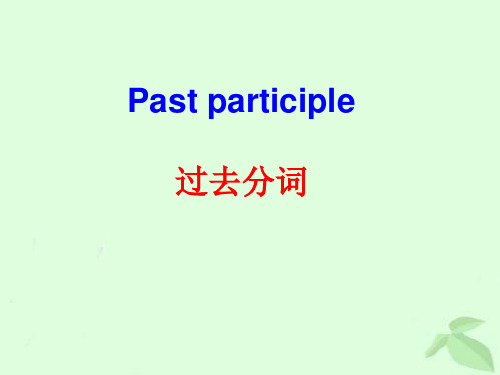
last night. • 3. The angry couple are trying to make
themselves heard.
Find out the rules: 过去分词紧跟在__宾__语__(谓语/宾语) 之后作宾__语__补__足__语__,用于补充完整 宾语的含义,过去分词与宾语存 在_被__动__(主动/被动)关系。
• (If it is) heated, water changes into steam. • 条件状语
• (Although he was) defeated again, he didn’t lose heart. 让步状语
• The professor went into the courtyard, (and he was) followed by his wife. 伴随状语
• The staff in the office are_e_x_c_it_e_d_.
办公室职员都 很兴奋。
• The engineer is_c_o_n_f_u_s_ed_.
这个工程师感
到很迷惑。
• The audience in the theater are__s_h_o_c_k_e_d_.
• 1. Seen from space, the earth looks like a big blue ball.
• 2. Moved by the film, he started crying. • 3. Heated, water changes into steam. • 4. Defeated again, he didn’t lose heart. • 5. The professor went into the
themselves heard.
Find out the rules: 过去分词紧跟在__宾__语__(谓语/宾语) 之后作宾__语__补__足__语__,用于补充完整 宾语的含义,过去分词与宾语存 在_被__动__(主动/被动)关系。
• (If it is) heated, water changes into steam. • 条件状语
• (Although he was) defeated again, he didn’t lose heart. 让步状语
• The professor went into the courtyard, (and he was) followed by his wife. 伴随状语
• The staff in the office are_e_x_c_it_e_d_.
办公室职员都 很兴奋。
• The engineer is_c_o_n_f_u_s_ed_.
这个工程师感
到很迷惑。
• The audience in the theater are__s_h_o_c_k_e_d_.
• 1. Seen from space, the earth looks like a big blue ball.
• 2. Moved by the film, he started crying. • 3. Heated, water changes into steam. • 4. Defeated again, he didn’t lose heart. • 5. The professor went into the
人教版高二英语必修5过去分词语法讲解(课堂PPT)
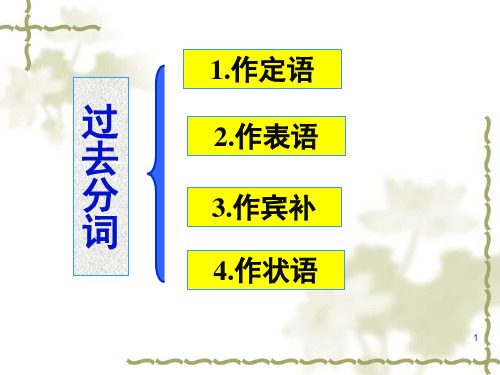
1.作定语
过 去
2.作表语
分 词
3.作宾补
4.作状语
1
The Past Participle used as
Attribute
2
过去分词作定语
. 教学目标 1、过去分词作定语的意义
. 2、过去分词作定语的位置
3、过去分词作定语与现在分词作定语的 区别
.
3
过去分词作定语
过去分词作定语的基本用法 1.过去分词作定语的意义
反展中国家
developed countries
发达国家
falling leaves
落叶(正在进行)
fallen leaves
落叶(已经完成) 12
The child standing over there is my brother.
The room facing south is our classroom. The book written by Lu Xun is very good. The road completed yesterday is leading
The water
___________________________(送到她家
的水) carried disease.
16
The English today is quite different from the
English __________________的位置
(1)单个的过去分词作定语一般放在被 修饰的名词之前,但left 、given只作后 置定语
1.The broken vase has been thrown outside. 2.The wounded soldier was looked after
过 去
2.作表语
分 词
3.作宾补
4.作状语
1
The Past Participle used as
Attribute
2
过去分词作定语
. 教学目标 1、过去分词作定语的意义
. 2、过去分词作定语的位置
3、过去分词作定语与现在分词作定语的 区别
.
3
过去分词作定语
过去分词作定语的基本用法 1.过去分词作定语的意义
反展中国家
developed countries
发达国家
falling leaves
落叶(正在进行)
fallen leaves
落叶(已经完成) 12
The child standing over there is my brother.
The room facing south is our classroom. The book written by Lu Xun is very good. The road completed yesterday is leading
The water
___________________________(送到她家
的水) carried disease.
16
The English today is quite different from the
English __________________的位置
(1)单个的过去分词作定语一般放在被 修饰的名词之前,但left 、given只作后 置定语
1.The broken vase has been thrown outside. 2.The wounded soldier was looked after
过去分词用法-PPT课件

•9
定语
3. 被修饰词是由 不定代词 Every/ some/ any/no + thing/ body 所构成的,V-ed后置。 例:有人受伤吗? Is anybody injured?
•10
定语
4. V-ed 短语做(后置)定语,相当于定语从句 He is reading a novel written by Lu Xun. He is reading a novel (which was) written by Lu Xun.
•23
宾语补足语
• 3. 表“希望”、“要求”、“命令” 等 • 如 like, want, wish, order……
例:我可不想我的女儿天黑以后被带出去 I don’t want my daughter to be taken out after dark.
* Want to do sth. Want sb./ sth. done (被动)
•24
宾语补足语
• (to) V./ V-ing/ V-ed 作宾补的区别 I saw him take away the book just now. 主动(结果) I saw him taking away the book on the desk正. 在(过程) I saw the book taken away by a child. 被动
* See sb./ sth. done
•21
宾语补足语
2. 表“使让” 使役动词(let, make, get, keep, leave, have) + V-ed, 表使让。
It was so cold that the driver couldn’t get the car started.
定语
3. 被修饰词是由 不定代词 Every/ some/ any/no + thing/ body 所构成的,V-ed后置。 例:有人受伤吗? Is anybody injured?
•10
定语
4. V-ed 短语做(后置)定语,相当于定语从句 He is reading a novel written by Lu Xun. He is reading a novel (which was) written by Lu Xun.
•23
宾语补足语
• 3. 表“希望”、“要求”、“命令” 等 • 如 like, want, wish, order……
例:我可不想我的女儿天黑以后被带出去 I don’t want my daughter to be taken out after dark.
* Want to do sth. Want sb./ sth. done (被动)
•24
宾语补足语
• (to) V./ V-ing/ V-ed 作宾补的区别 I saw him take away the book just now. 主动(结果) I saw him taking away the book on the desk正. 在(过程) I saw the book taken away by a child. 被动
* See sb./ sth. done
•21
宾语补足语
2. 表“使让” 使役动词(let, make, get, keep, leave, have) + V-ed, 表使让。
It was so cold that the driver couldn’t get the car started.
过去分词用法详解ppt课件
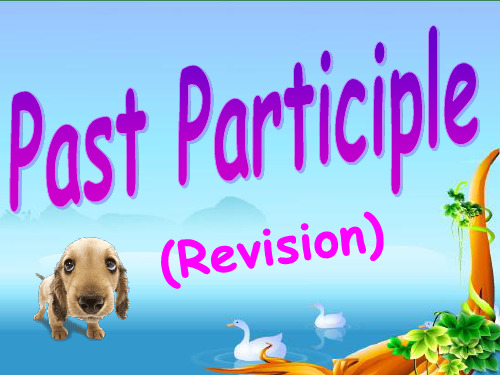
A. recorded
B. record
D. having recorded
4.Linda worked for the Minnesota Manufacturing and Mining
company, _B__as 3M.(04’ZJ)
A. knowing B. known C. being known D. to be known
6
﹡ ﹡ The differences (used as Attribute)
5. to do 表示一个将来的动作 to be done 表示一个将来的被动动作 doing 表示一个正在进行的主动动作 being done 表示一个正在进行的被动动作 e.g. I have much work to do. The building to be finished at the end of this year will be our lab
2.介词with+宾语+过去分词
The thief was brought in with his hands tied behind his back. With all the work finished, he went back.
15
Exercises:
1.You should understand the traffic rule by now. You’ve had it
5.----Shall we go swimming ?
----OK. I’ll just go and get __A___.
A. changed B. to change C. to be changed D. changing
13
Step Ⅲ used as Object Complement 1.及物动词的过去分词作宾补表示一个完成且被动的动 作; 不及物动词的过去分词作宾补只表示动作的完成和 状态。
高二-过去分词做定语和表语课件ppt.ppt

The glass is broken. (是过去分词做表语)
The glass is broken by the naughty boy. (是动词的被动语态)
结论:过去分词做表语,强调的是主语
所处的_状__态___,而动词的被动语态表示的 是一个__动_作____.
过去分词作表语一般用来表示感受或状 在日常生活中,随处都可以看到浪费粮食的现象。也许你并未意识到自己在浪费,也许你认为浪费这一点点算不了什么 态。此时的过去分词作表语相当于一个形容 词。 No wonder he is excited! (predicative) 可以用作表语的常见的过去分词有: 1.表情感的过去分词: delighted, disappointed, upset, astonished, excited, frightened, experienced, interested, qualified, puzzled, exhausted, satisfied
= A thief stole the goat _t_ie_d___ to the tree. 2. The girl who is dressed in red is Kelly’s
long-lost friend. = The girl _d_r_e_ss_e_d__in__r_e_d_ is Kelly’s long-lost friend.
在日常生活中,随处都可以看到浪费 粮食的 现象。 也许你 并未意 识到自 己在浪 费,也 许你认 为浪费 这一点 点算不 了什么
2.表状态的一些过去分词:
lost ; seated ; hidden ; lost / absorbed in ;born ; dressed in ; tired of 。 Eg.飞机着陆的时候乘客要保持就座的状态。
The glass is broken by the naughty boy. (是动词的被动语态)
结论:过去分词做表语,强调的是主语
所处的_状__态___,而动词的被动语态表示的 是一个__动_作____.
过去分词作表语一般用来表示感受或状 在日常生活中,随处都可以看到浪费粮食的现象。也许你并未意识到自己在浪费,也许你认为浪费这一点点算不了什么 态。此时的过去分词作表语相当于一个形容 词。 No wonder he is excited! (predicative) 可以用作表语的常见的过去分词有: 1.表情感的过去分词: delighted, disappointed, upset, astonished, excited, frightened, experienced, interested, qualified, puzzled, exhausted, satisfied
= A thief stole the goat _t_ie_d___ to the tree. 2. The girl who is dressed in red is Kelly’s
long-lost friend. = The girl _d_r_e_ss_e_d__in__r_e_d_ is Kelly’s long-lost friend.
在日常生活中,随处都可以看到浪费 粮食的 现象。 也许你 并未意 识到自 己在浪 费,也 许你认 为浪费 这一点 点算不 了什么
2.表状态的一些过去分词:
lost ; seated ; hidden ; lost / absorbed in ;born ; dressed in ; tired of 。 Eg.飞机着陆的时候乘客要保持就座的状态。
高中英语过去分词用法详解课件可修改文字

the young lady was no longer afraid.
第八页,本课件共66页
2. Because it was done in a hurry, his homework was full of mistakes. Done in a hurry, his homework was full of mistakes.
Exhausted, I slid into bed and fell fast asleep.
第二十四页,本课件共66页
Compare
1. Following the old man, we went
upstairs.—we followed
(跟着那个老人, 我们上去了)
2. Followed by the old man, we went
由于用了很长时间,这本书看上去很旧.
_U_s_i_n_g_ the book, I find it useful. 在使用的过程中,我发现这本书很有用. _L_o_o__k_in__gat her, he jumped with joy. _L_o_o_k_e_d_at by her, he jumped with joy.
第二十七页,本课件共66页
注意: 选择现在分词还是过去分词, 关 键看主句的主语。如分词的动作是主 句的主语发出, 分词就选用现在分词,反
之就用过去分词。
第二十八页,本课件共66页
Complete each sentence using the Past Participle of the right verb.
froAm the space, the astronaut can not
discover the Great Wall. A.
第八页,本课件共66页
2. Because it was done in a hurry, his homework was full of mistakes. Done in a hurry, his homework was full of mistakes.
Exhausted, I slid into bed and fell fast asleep.
第二十四页,本课件共66页
Compare
1. Following the old man, we went
upstairs.—we followed
(跟着那个老人, 我们上去了)
2. Followed by the old man, we went
由于用了很长时间,这本书看上去很旧.
_U_s_i_n_g_ the book, I find it useful. 在使用的过程中,我发现这本书很有用. _L_o_o__k_in__gat her, he jumped with joy. _L_o_o_k_e_d_at by her, he jumped with joy.
第二十七页,本课件共66页
注意: 选择现在分词还是过去分词, 关 键看主句的主语。如分词的动作是主 句的主语发出, 分词就选用现在分词,反
之就用过去分词。
第二十八页,本课件共66页
Complete each sentence using the Past Participle of the right verb.
froAm the space, the astronaut can not
discover the Great Wall. A.
Unit5MusicDiscoveringUsefulStructures过去分词语法课件高一英语人

要点三:
个别情况下,主语是人也可表示 “令人/使别人感 到...”; 主语是物也可表示 “感到/觉得...”。
He is terrifying. 他很吓人。(指他的长相或举动令人害怕) He is terrified. 他很害怕。 Please describe a dog that is frightened. 请描述一只惊恐的狗。(狗受到
2. Asked why he didn’t do it, he began to cry. = When he was asked why he didn't do it, he began to cry.
过去分词短语做状语表时间,相当于一个由when, while, until, afrer等引导的 __时__间__状__语__从__句__。
2. 表条件 1. G如i果ve给n予m更o多re时t间ime, we could do it much better. =If we were given more time, we could do it much better.
2. Com如pa果r跟ed我w的i兄th弟m比y较brother, I should make greater efforts to study English.
4、表方式、伴随 1. He walked up and down the room, lost in thought. =He walked up and down the room, and he was lost in thought.
2. Supported by his wife, the old man went into the room. =The old man was supported by his wife, and he went into the room.
- 1、下载文档前请自行甄别文档内容的完整性,平台不提供额外的编辑、内容补充、找答案等附加服务。
- 2、"仅部分预览"的文档,不可在线预览部分如存在完整性等问题,可反馈申请退款(可完整预览的文档不适用该条件!)。
- 3、如文档侵犯您的权益,请联系客服反馈,我们会尽快为您处理(人工客服工作时间:9:00-18:30)。
2) 过去分词作状语时,过去分词的逻辑 主语与句子主语一致。
14
过去分词作状语:
过去分词有两大特点:
1. 表示被动的动作; 2. 表示已经完成的动作, 因此,当过去分
词作状语的时候一定要搞清楚分词与 主语的逻辑关系--被动, 例如:
15
Rewrite with proper conjunctions
→When he was asked what had happened, he told us about it.
3. Well known for his expert advice, he received many invitations to give lectures.
→Because he was well known for his expert advice, he received many invitations to give lectures.
12
2. She sat by the window, lost in thought. She sat by the window, and she was lost in thought. lost 表示一种迷失心理状态
13
Summary
1) 过去分词在句子中可以作时间状语、 原因状语、伴随状语、条件状语和 让步状语等。
Grammar
1.作状语
过 去
2.作定语
分 词
3.作宾补
4.作表语
1
过去分词 过去分词是非谓语动词的一种形式, 表示完成和被动的动作。它在句子 中可以充当状语、定语等成分。
2
一、过去分词作状语
过去分词与现在分词作状语 过去分词表完成、被动, 与主句主语之间 是被动关系; 现在分词表进行、主动, 与 主句主语之间是主动关系。如果一个被动 的动作发生在谓语动词之前, 则可使用现在 分词的完成被动式或过去分词。
7
过去分词作原因状语
1. Since/ As she was given advice by the famous detective, the young lady was no longer afraid. Given advice by the famous detective, the young lady was no longer afraid.
3
过去分词表完成、被动, 作状语时, 其逻辑主语是主句的主语, 且与主语 之间存在着被动关系。过去分词作 状语可表时间、原因、 让步、 结果、 方式、 条件等。
4
观察下列的句子:
Once published, his works (=Once his works was published, ) became famous for the absence of rhyme at the end of each line. PP作时间状语, 相当于一个时间状语 从句有时过去分词前可加连词when或 while来强调时间概念。
18
6. Deeply interested in medicine, she decided to become a doctor. Because she was deeply interested in medicine, she decided to become a doctor.
5
过去分词作时间状语
1. When it is heated, ice will be changed into water. When heated, ice will be changed into water.
6
2. When it is seen under a microscope, a fresh snowflake has a delicate sixpointed shape. Seen under a microscope, a fresh snowflake has a delicate six-pointed shape.
Example:
1. United we stand, divided we fail. If we are united, we will stand, but if we are divided, we will fail.
16
பைடு நூலகம்
2. Asked what had happened, he told us about it.
10
2. If I am compared with you, we still have a long way to go. Compared with you, we still have a long way to go.
11
作方式或伴随情况状语
1. The hunter left his house, followed by his dog. The hunter left his house, and he was followed by his dog.
8
2. Because it was done in a hurry, his homework was full of mistakes. Done in a hurry, his homework was full of mistakes.
9
过去分词作条件或者假设状语
1. If they had been given more attention, the cabbages could have grown better. Given more attention, the cabbages could have grown better.
17
4. Given more time, we would be able to do the work much better. If we were given more time, we would be able to do the work much better.
5. Once translated into Chinese, the book became very popular among Chinese teenagers. Once it was translated into Chinese, the book became very popular among Chinese teenagers.
14
过去分词作状语:
过去分词有两大特点:
1. 表示被动的动作; 2. 表示已经完成的动作, 因此,当过去分
词作状语的时候一定要搞清楚分词与 主语的逻辑关系--被动, 例如:
15
Rewrite with proper conjunctions
→When he was asked what had happened, he told us about it.
3. Well known for his expert advice, he received many invitations to give lectures.
→Because he was well known for his expert advice, he received many invitations to give lectures.
12
2. She sat by the window, lost in thought. She sat by the window, and she was lost in thought. lost 表示一种迷失心理状态
13
Summary
1) 过去分词在句子中可以作时间状语、 原因状语、伴随状语、条件状语和 让步状语等。
Grammar
1.作状语
过 去
2.作定语
分 词
3.作宾补
4.作表语
1
过去分词 过去分词是非谓语动词的一种形式, 表示完成和被动的动作。它在句子 中可以充当状语、定语等成分。
2
一、过去分词作状语
过去分词与现在分词作状语 过去分词表完成、被动, 与主句主语之间 是被动关系; 现在分词表进行、主动, 与 主句主语之间是主动关系。如果一个被动 的动作发生在谓语动词之前, 则可使用现在 分词的完成被动式或过去分词。
7
过去分词作原因状语
1. Since/ As she was given advice by the famous detective, the young lady was no longer afraid. Given advice by the famous detective, the young lady was no longer afraid.
3
过去分词表完成、被动, 作状语时, 其逻辑主语是主句的主语, 且与主语 之间存在着被动关系。过去分词作 状语可表时间、原因、 让步、 结果、 方式、 条件等。
4
观察下列的句子:
Once published, his works (=Once his works was published, ) became famous for the absence of rhyme at the end of each line. PP作时间状语, 相当于一个时间状语 从句有时过去分词前可加连词when或 while来强调时间概念。
18
6. Deeply interested in medicine, she decided to become a doctor. Because she was deeply interested in medicine, she decided to become a doctor.
5
过去分词作时间状语
1. When it is heated, ice will be changed into water. When heated, ice will be changed into water.
6
2. When it is seen under a microscope, a fresh snowflake has a delicate sixpointed shape. Seen under a microscope, a fresh snowflake has a delicate six-pointed shape.
Example:
1. United we stand, divided we fail. If we are united, we will stand, but if we are divided, we will fail.
16
பைடு நூலகம்
2. Asked what had happened, he told us about it.
10
2. If I am compared with you, we still have a long way to go. Compared with you, we still have a long way to go.
11
作方式或伴随情况状语
1. The hunter left his house, followed by his dog. The hunter left his house, and he was followed by his dog.
8
2. Because it was done in a hurry, his homework was full of mistakes. Done in a hurry, his homework was full of mistakes.
9
过去分词作条件或者假设状语
1. If they had been given more attention, the cabbages could have grown better. Given more attention, the cabbages could have grown better.
17
4. Given more time, we would be able to do the work much better. If we were given more time, we would be able to do the work much better.
5. Once translated into Chinese, the book became very popular among Chinese teenagers. Once it was translated into Chinese, the book became very popular among Chinese teenagers.
